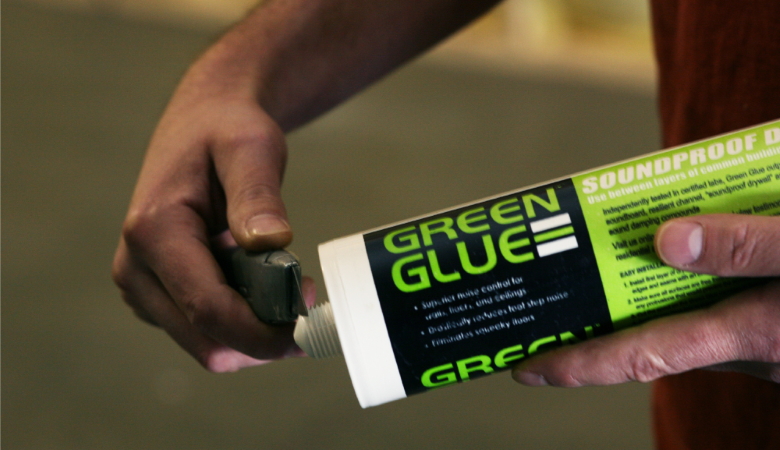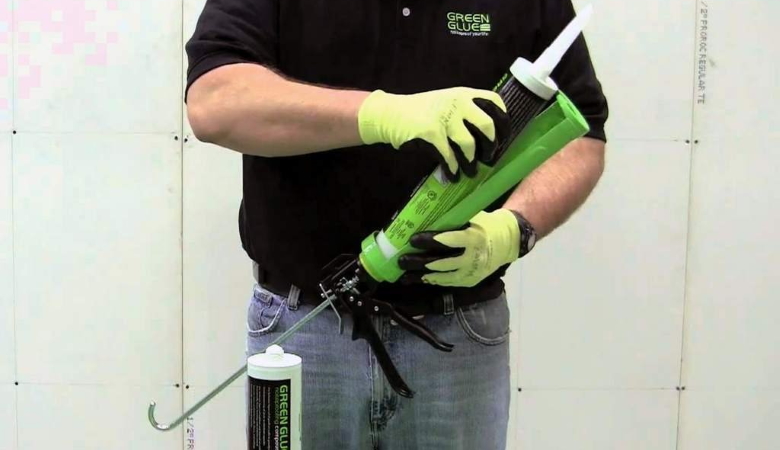
When you on the search for a noise-free space at home, you’ll try just about anything to make a difference.
Green Glue is a popular material used for soundproofing, and whether you use it on its own or with other products like drywall, you’re bound to have heard about it before.
Does Green Glue soundproofing really work?
Green Glue is the product name of a type of viscoelastic damping compound that aims to provide a barrier from sound, and it’s most commonly applied in between layers of drywall.
People have achieved good results from Green Glue and it’s a popular method of soundproofing, but may not work in every situation.
Before you start applying this compound to your walls, you need to know the ins and the outs of it.
We’re here to help with a detailed look at Green Glue and how this viscoelastic damping compound works at muffling and reducing sound, so you’ll know whether it’s the right fit for you.
What Is Green Glue?
Green Glue is a product sold to provide soundproofing abelites and it acts as a sealant or compound.
The glue is actually a viscoelastic damping compound, with the name ‘Green Glue’ merely being a product name, and there are others on the market that work the same.
This product is a popular choice for people wanting to soundproof a room and reduce the noise from things like televisions and stereo systems.
It’s applied to floors, walls, and ceilings, and most commonly sandwiched in between two layers of drywall, helping to reduce the amount of sound that travels through these structures.
How Does It Work?

One of the biggest issues when soundproofing a room is dealing with vibrations, and Green Glue is a type of sealant that dampens these vibrations. The glue works by increasing the damping of the structures that it’s attached to, like drywall, and then dissipates the sound and vibration as it travels through them.
Sound travels on a specific path and it can easily go through walls, windows, and other materials with ease.
The transmission of this sound and the path it takes is referred to as “flanking sound”, and these types of damping compounds aim to make it harder for it to travel but also reduce the amount of noise that comes through the structures.
The application of Green Glue and other similar products is usually done on the drywall in between two sheets and works best for frequencies below 100Hz.
Various tests have been performed to evaluate the effectiveness of these types of glues and found that in most cases, they provide some sound barrier, especially for the transmission of sounds like home theatre systems and music, so should be considered.
The Good and the Bad
To get a better understanding of Green Glue and its best and worst features, we’ve outlined some of the most obvious pros and cons.
This can give you a more critical look at the product and see if this type of compound is a good choice for your soundproofing plans.
Pros
- Green Glue has been tested for safety and is low in VOC, is cleaned easily off surfaces, is fire safe, and has virtually no odor, so there’s no drawback to using it in the home.
- You can apply Green Glue and similar products in both residential and commercial buildings and find that it helps with many of the sound types and frequencies that are experienced in these settings.
- The application of Green Glue is easy and doesn’t need to be done by a professional. If you’re already installing new drywall it can be applied in minutes but you’ll need to give it time to set before you can finish the job.
Cons
- The cost of Green Glue and other compounds can stack up, especially if you’re trying to soundproof more than one wall. When you combine it with a soundproofing drywall product, it can be expensive.
- Green Glue isn’t ideal for impact noises, so if you’re trying to reduce the sound of something hitting a structure or other structure-borne noise, it won’t be successful. You’ll need to look at other methods of soundproofing if this is your issue.
How To Use Green Glue?

Green Glue was designed to be easy to use, and as such, there’s no need for additional materials like a trowel, and it can be applied with a standard caulk gun.
It takes less than a minute to apply a tube, provided you have your sheets ready, and the glue will dispense without much work.
- Attach the first layer of drywall that you’re installing and be sure to seal around the edges, the perimeter, and the seams between each sheet.
- Cut the end of the Green Glue tube and replace the nozzle with the one included. Cut the tip of the nozzle to leave an opening of at least 3/8 inch.
- Apply the glue in small beads randomly around the second sheet of drywall that you plan on sticking to the first. Leave at least a two-inch border around the whole perimeter of the drywall so you can pick it up easily.
- Once the glue has been applied to the whole board, pick it up and carefully attach it to the already fastened sheet of drywall. Use the recommended screws to keep it in place. Do not leave the glued sheet to sit for more than 15 minutes otherwise, it will start to dry.
Glue Down the Sound
Products like Green Glue and other damping compounds have the potential to be most helpful when used in the right settings and applied correctly.
Although they won’t have much use on their own, they can combine with other methods like soundproofing drywall to create an easy and effective way to reduce sound in domestic or commercial space.
Related Questions

Green Glue is just one option out there for the DIYer looking to fix their sound problems at home, and there’s a lot more out there to learn about.
If you’re still unsure what route to take when doing your own soundproofing work, we’ve answered a few more questions about the process and this specific material to help you get started.
Is Green Glue Waterproof?
Although this compound is ideal for blocking sound, it should not be applied as a water sealant and is not considered waterproof.
After applying the product to a wall or other structure, you’ll need to wait at least 48 hours for it to dry before adding any finishes or painting it, otherwise, it will lose its effectiveness.
How Much Green Glue Do I Need?
According to the manufacturer, the recommended application of Green Glue is two tubes for every 4 x 8′ sheet of drywall. This equates to around two tubes for a standard sheet, although you will achieve better sound damping results if you use three tubes per sheet, as long as you can afford it.
Is Green Glue Fire Rated?
If you’re concerned about the fire safety recommendations of Green Glue, the good news is that it’s classified as a Class A fire-rated material. There are no harmful fumes or materials associated with Green Glue and no need to worry about its safety when applying it in your home.
Resources
